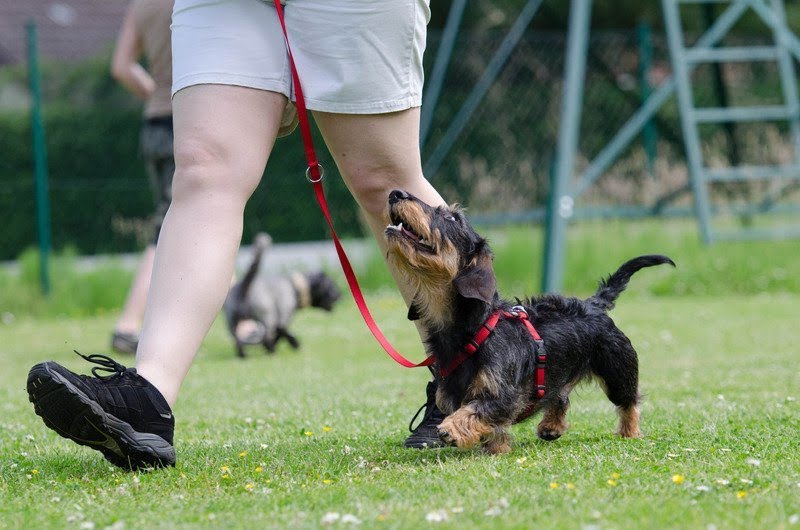Dogs are known for their intelligence and ability to learn, but can dogs train each other? Dog training is an essential aspect of responsible pet ownership, influencing a dog’s behavior and ensuring they can live harmoniously with humans.
However, the idea of dogs training each other raises interesting questions about their social dynamics and learning capabilities. This article will explore the topic of whether dogs can train each other, examining the ways in which dogs communicate and learn from one another, the concept of observational learning in dogs, leadership and hierarchy within dog packs, teaching new behaviors to other dogs, canine behavior modification by other dogs, as well as the limitations of dogs training each other.
The social nature of dogs plays a significant role in their ability to communicate and learn from each other. Through body language, vocalizations, and general behavior, dogs have a unique way of interacting and conveying information to one another. This social aspect sets the foundation for understanding whether dogs can indeed train each other.
Observational learning is a fascinating concept that has been observed in various species, including dogs. By observing and imitating the behaviors of their peers, dogs may learn new skills or modify their own actions. Understanding how observational learning functions among dogs will provide insights into whether they can positively influence each other’s behavior through this method.
Can Dogs Communicate and Learn From Each Other?
Dogs are highly social animals, and their ability to communicate with each other is a crucial aspect of their behavior. They use a combination of body language, vocalizations, and scent to convey information and messages to one another. Through these forms of communication, dogs can learn from each other in various ways. For example, when one dog exhibits a certain behavior or learns a new skill, other dogs in the social group can observe and potentially imitate that behavior.
One significant way that dogs communicate with each other is through play. Play behavior allows dogs to practice vital social skills such as cooperation, communication, and problem-solving. Younger dogs often learn from older, more experienced dogs during play sessions. Additionally, observing the interactions between other dogs within their pack or social group can help individual dogs gain a better understanding of social dynamics and proper conduct.
Not only do dogs learn from each other’s behaviors, but they also transmit information about the environment to one another. Scent marking is one way that dogs communicate valuable information about territory boundaries, potential food sources, or the presence of danger.
When one dog picks up on cues from another dog’s scent marking behavior, it can influence their own responses and decisions. All these examples demonstrate how the ability of dogs to communicate with each other plays a significant role in their learning from one another.
| Aspect of Communication | Impact on Dog Learning |
|---|---|
| Play Behavior | Allows for practice of vital social skills |
| Scent Marking | Transmits crucial environmental information |
| Observation of Social Interactions | Aids in understanding social dynamics |
Observational Learning in Dogs
Dogs are highly social animals, and their ability to learn from each other through observation is a fascinating aspect of their behavior. Observational learning refers to the process of acquiring new behaviors or information by watching others. In the case of dogs, this can occur within their own social groups, such as packs or even just within a group of dogs at a dog park.
Examples of observational learning in dogs include behaviors like howling, hunting, or even performing tricks. One dog may observe another successfully performing a task and then attempt to replicate that behavior themselves. This form of learning can be especially beneficial when it comes to teaching puppies new skills or helping them adapt to certain environments.
To further understand observational learning in dogs, various studies have been conducted on the topic. For instance, researchers have observed instances where one dog learns from another through simple observation without any direct instruction or reinforcement from humans. In some cases, this type of learning can be more effective and efficient than traditional human-directed training methods.
In addition to specific behaviors, observational learning among dogs also plays a role in shaping their social interactions and hierarchies. By observing the actions and reactions of other dogs within their social group, individual dogs can learn about dominant and submissive behaviors, communication cues, and how to navigate the complex dynamics of pack life. Understanding how observational learning influences both behavior and social structure provides valuable insight into the ways dogs interact with each other in various settings.
- Examples of observational learning in dogs
- Mimicking howling behavior
- Copying hunting techniques
- Replicating tricks or commands
- Research findings on observational learning
- Studies showing successful imitation among dogs
- Effectiveness compared to human-directed training
- Impact on social structure
- Learning dominant/submissive behaviors
- Understanding communication cues
Leadership and Hierarchy Within Dog Packs
Dogs are social animals that naturally form pack structures, with a clear hierarchy and leadership. This is an important aspect of their behavior and has implications for how they interact and learn from each other.
In a dog pack, there is usually an alpha dog, which is the leader of the pack, followed by beta dogs and so on. The role of alpha dogs in a pack is crucial as they are responsible for making decisions and maintaining order within the group.
Establishing social order within a pack is vital for the smooth functioning of the group. Dogs use body language, vocalizations, and other forms of communication to establish and maintain their place in the hierarchy. By observing the interactions within their pack, dogs learn about leadership dynamics and social order. This provides them with valuable insights into how to behave within their community or when interacting with other dogs.
The impact of hierarchy on learning and training among dogs is significant. Lower-ranking dogs often observe and learn from higher-ranking ones through various interactions such as play, feeding times, and general day-to-day activities. This observational learning helps in shaping their behavior, as they understand what is expected of them within the pack. Additionally, it also influences how they may interact with humans or other animals outside of the pack structure.
Teaching New Behaviors to Other Dogs
Dogs have a remarkable ability to influence each other’s behavior and can even teach new behaviors to one another. Through their social interactions, dogs are able to demonstrate and reinforce certain actions, leading to observational learning among their peers. This form of learning is particularly evident during playtime, as dogs engage in various activities that can result in the transmission of behaviors from one dog to another.
One way in which dogs teach each other new behaviors is through play. During playtime, dogs can pick up new actions simply by watching and mimicking the behavior of other dogs. For example, a dog may observe another one successfully performing a trick or command and then attempt to imitate it. Additionally, positive social interactions such as playing with toys or engaging in group activities can also foster the learning of new behaviors among dogs.
Furthermore, there are instances where dogs may be more effective at teaching each other certain behaviors than humans. This is especially true when it comes to behaviors that are specific to canine communication and socialization. As pack animals, dogs have a deep understanding of social cues and body language, allowing them to convey information and teach appropriate behaviors within their own species.
| Topic | Data |
|---|---|
| Dogs learn through play | Dogs can pick up new actions by observing others during playtime. |
| Effectiveness of dogs teaching each other | Dogs may be more effective at teaching certain behaviors related to canine communication and socialization than humans. |
Canine Behavior Modification by Other Dogs
Dogs are highly social animals, and their interactions with other dogs play a significant role in their behavior and development. One interesting aspect of this is the way in which dogs can modify each other’s behavior. This phenomenon, known as canine behavior modification, is an important part of how dogs learn from one another and adapt their own behaviors.
Observation plays a key role in canine behavior modification. When one dog observes another dog exhibiting a certain behavior, such as successfully using a particular strategy to obtain food or navigate an obstacle, they may then mimic that behavior themselves. This type of observational learning is especially common among puppies, who often learn by watching and imitating older or more experienced dogs.
In addition to observational learning, dogs also engage in social learning through their interactions with other dogs. For example, when a young or inexperienced dog displays undesirable behavior, such as excessive barking or aggression during playtime, older dogs may intervene and teach the younger dog appropriate behaviors through corrective actions or signals. These interactions help to shape the behavioral responses of the younger dog and can lead to lasting changes in their conduct.
Overall, the ability of dogs to modify each other’s behavior highlights the importance of socialization and positive interactions within a canine community. While human intervention is crucial for training and shaping a dog’s behavior, the influence that dogs have on each other should not be underestimated. By understanding how canine behavior modification occurs, owners and trainers can use this knowledge to foster positive socialization experiences for their pets and promote healthy interaction within the canine community.
The Limitations of Dogs Training Each Other
The concept of dogs training each other is fascinating, but it also has its limitations that need to be considered. While dogs are social creatures and can learn from each other, there are factors that can hinder or limit their ability to effectively train one another.
Factors That Can Hinder or Limit Dogs Training Each Other
One of the key limitations of dogs training each other is the individual personality and temperament of each dog. Just like humans, dogs have their own unique personalities, behaviors, and learning styles. What works for one dog may not work for another, and this variation in personalities can make it challenging for one dog to effectively train another.
Another factor that can hinder dogs training each other is the lack of clear communication. While dogs do communicate with each other through body language, vocalizations, and scent, they may not always understand or interpret these signals in the same way. This lack of clear communication can make it difficult for one dog to convey a specific training cue or command to another.
The Importance of Human Intervention in Dog Training
While dogs are capable of learning from each other, human intervention is essential in providing structured and consistent training for dogs. Professional trainers have a deep understanding of canine behavior and psychology, allowing them to tailor their training methods to suit the individual needs of each dog. Additionally, human trainers can provide guidance and support to ensure that the training process is effective and safe for all involved.
Cases Where Dogs May Not Be Able to Effectively Train Each Other
In some cases, certain behavioral issues or complex commands may require a level of expertise that only humans can provide. Aggression, anxiety, fearfulness, and compulsive behaviors are examples of issues that often require professional intervention from humans. Additionally, highly specialized tasks such as service dog work or search and rescue operations typically require human trainers with specific skills and knowledge.
Ultimately, while dogs can certainly learn from each other in many ways, there are limitations to their ability to effectively train one another. Human involvement remains crucial in providing structured and effective training for our canine companions.
Conclusion
In conclusion, the social nature of dogs and their ability to communicate and learn from each other suggests that they can indeed train each other. Observational learning among dogs has been well-documented, with numerous studies demonstrating how one dog can pick up behaviors and skills by observing another dog. Additionally, the concept of leadership and hierarchy within dog packs provides further evidence that dogs have the capacity to influence each other’s behavior and learning.
While it is clear that dogs have the potential to train each other, it is important to recognize the limitations of this phenomenon. Factors such as personality differences, physical limitations, and individual learning styles can hinder or limit the effectiveness of dogs training each other. Furthermore, human intervention in dog training remains crucial for providing guidance, structure, and consistency in teaching desired behaviors.
Ultimately, the relationship between dogs and humans in the training and socialization of dogs is a symbiotic one. While dogs may be able to teach each other certain behaviors through their social interactions, humans play a vital role in providing overall direction and support in shaping a well-behaved and well-adjusted canine companion.
With both dogs and humans working together, the potential for effective training and behavior modification is maximized, creating a harmonious coexistence between man’s best friend and their human counterparts.
Frequently Asked Questions
Can Dogs Train Other Dogs?
Some dogs can be trained to help train other dogs, especially if they have a good understanding of obedience and are well-behaved themselves. This can be particularly effective in environments where there are multiple dogs being trained at the same time, as the more experienced dog can set a positive example for the others.
Can Two Dogs Be Trained Together?
Yes, two dogs can be trained together, although it may require more effort from the trainer to ensure that both dogs are receiving equal attention and instruction. It’s important to establish boundaries and prevent one dog from dominating the training sessions or distracting the other dog. With consistency and patience, training two dogs together is definitely possible.
Can a Dog Learn Bad Habits From Another Dog?
Dogs can indeed learn bad habits from each other, especially if they spend a lot of time together or engage in similar behaviors. This is why it’s essential to monitor their interactions and correct any undesirable behavior promptly. Additionally, consistent training and setting clear rules can help prevent one dog from picking up bad habits from another.

Welcome to the blog! I am a professional dog trainer and have been working with dogs for many years. In this blog, I will be discussing various topics related to dog training, including tips, tricks, and advice. I hope you find this information helpful and informative. Thanks for reading!





